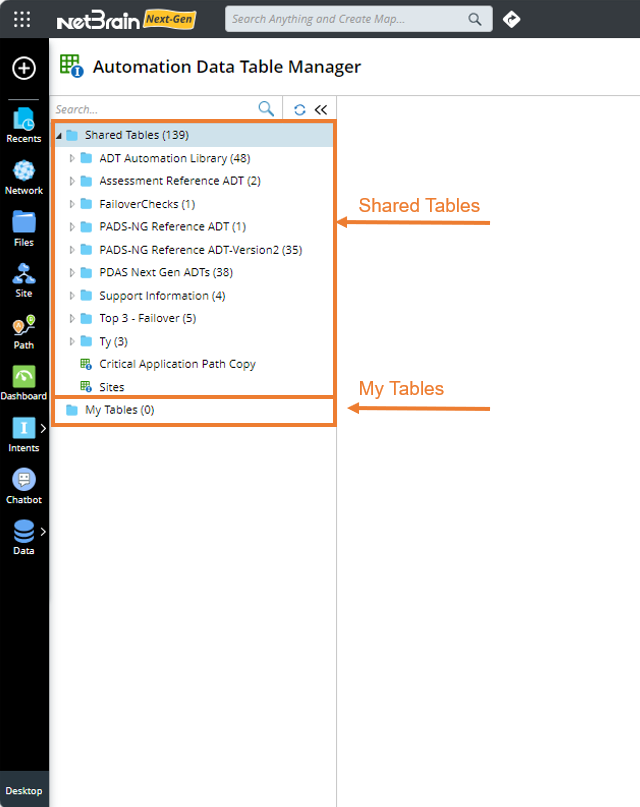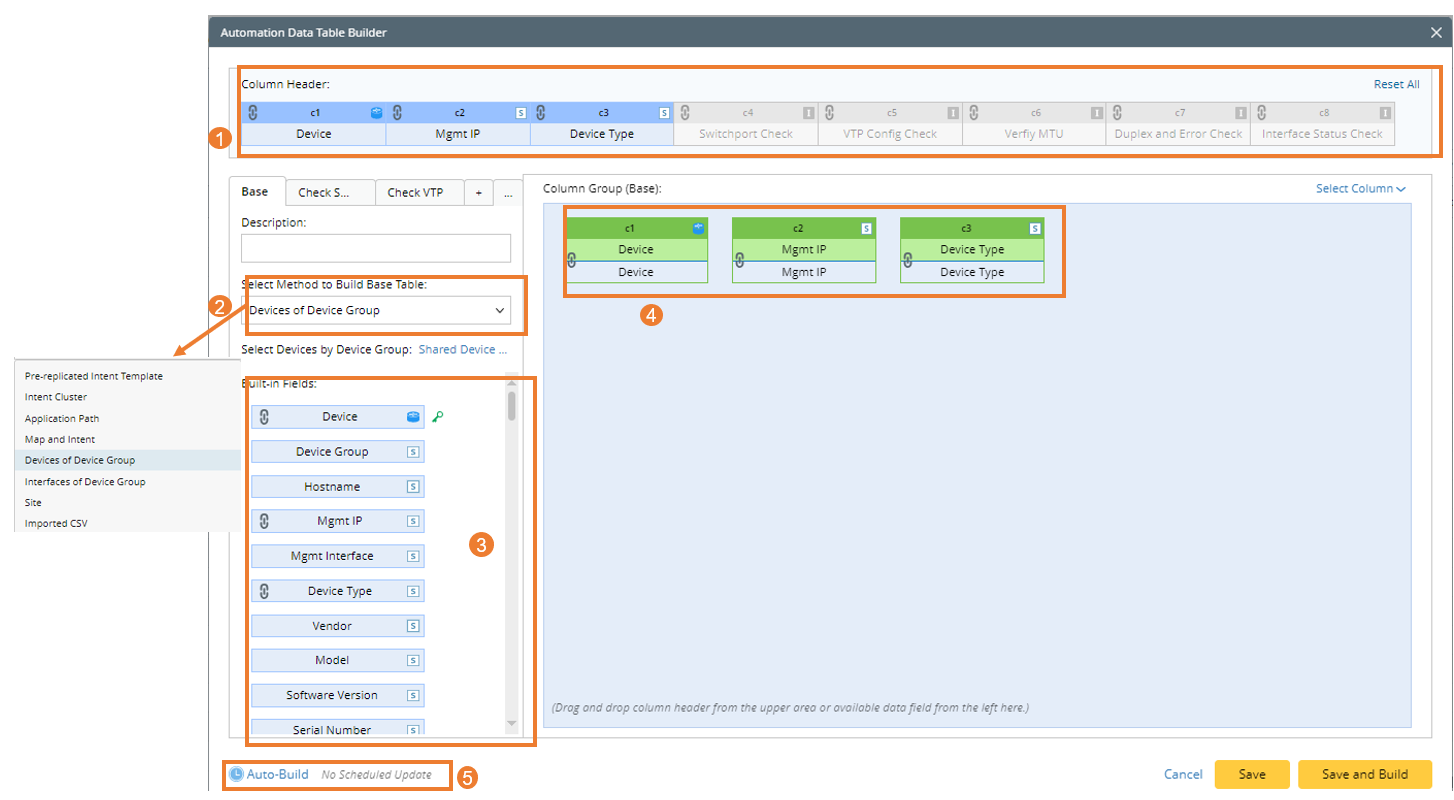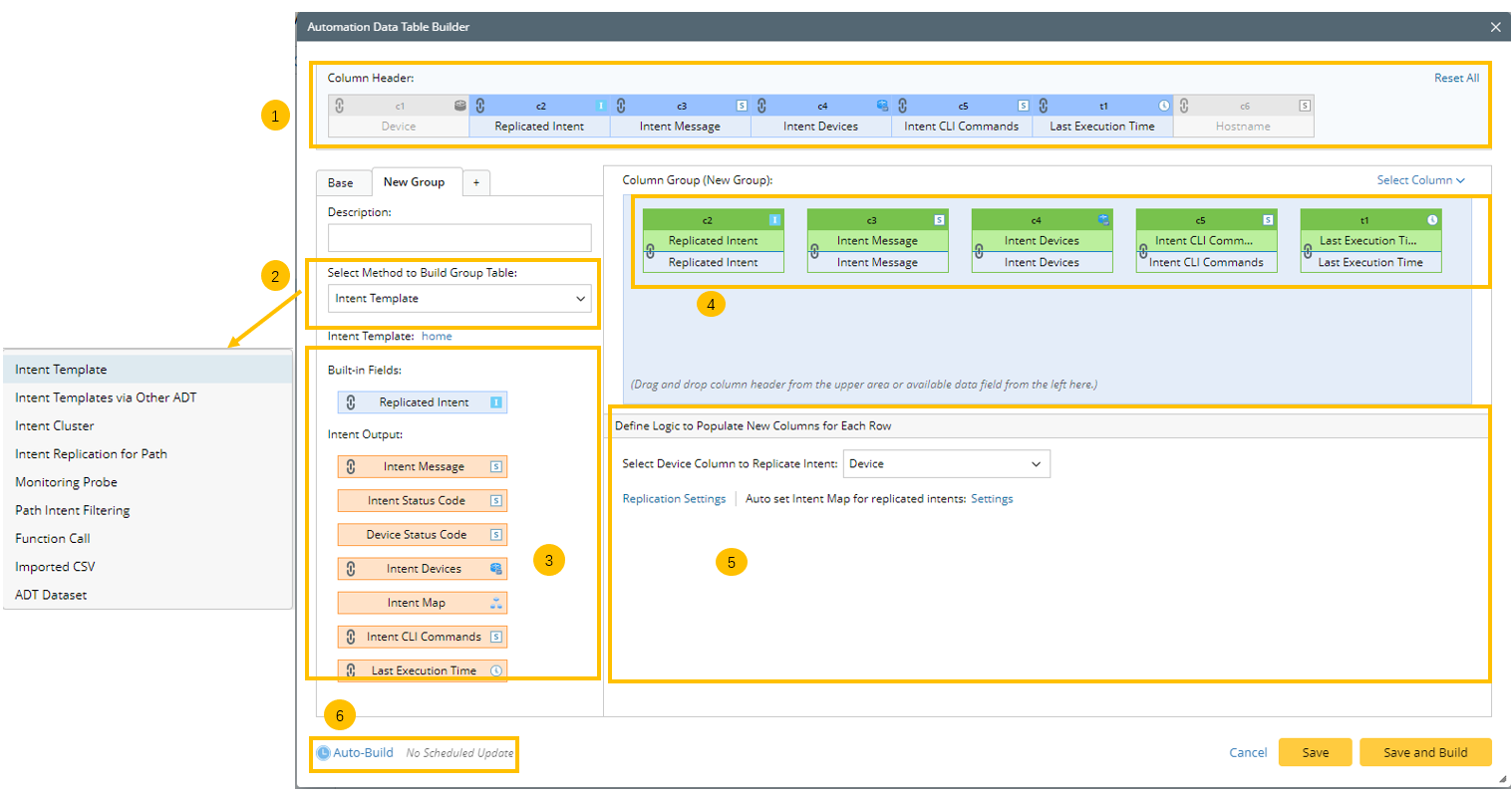Key Components of Automation Data Table
Automation Data Table Manager is a centralized management interface of ADTs where you can create, edit, and delete ADT, among other operations. It consists of the following components:
- Folder Tree structure: to organize shared tables and my tables.
- Table Operating Area: to edit, clear, and export data.
- Table Data Area for displaying the ADT data.
- Automation Data Table Builder for building ADT.
- Add Data Manually menu for manually editing data.

Key Components of Automation Data Table
- Folder Tree: A folder tree structure to organize and manage all the Shared Tables and My Tables.

- Table Operating Area:
Table Data: The final table data of an ADT. The components of an ADT are shown in the diagram below:
- Table Header: Display all the defined columns in the current ADT. Several operations on the column can be performed here such as, Edit, Delete or Set as Table Key.
- ADT Base Table: Base table contains basic source data for building automation assets in ADT. Base table is a way of building basic data. The system provides eight methods to create and populate the base table:
Table1 - Methods to Build Base Table MethodPopulated Columns Populated Rows Pre-replicated Intent Template - Replicated Intent
- Replicated Device
- Signature Variable
- Intent Output *
If there are different Signature Variables, each Signature Variable on a separate line.
Furthermore, the network attributes corresponding to the device can be extended by macro variables.
Intent Cluster - Member Intent Name
- Member Intent Devices
- Signature Variables (Dynamic)
- Intent Output *
1 member intent per row.
Furthermore, the attributes corresponding to the automation asset can be added as row data.
Application Path - Application Name
- Path
- Path Name
- Path Devices
- Path hops (device interfaces)
- Path Map
- Source
- Destination
- Path Status
1 path per row.
Furthermore, the path properties can be added as row data.
Map and Intent - Map
- Map Name
- Map Devices
- Map Device Interfaces
- Map Intent
- Intent Output *
1 map and 1 map intent per row.
Furthermore, the map can be added as row data.
Site - Site Name
- Devices in Site
- Site Map
- Site Map Intent
- Intent Output *
1 site and 1 site map intent per row.
Furthermore, the site properties can be added as row data.
Devices of Device Group - Device Name
- Device Group Name
- Device Properties (Dynamic)
1 device per row.
Furthermore, the device group name and properties can be added as row data.
Interfaces of Device Group - Interface
- Device
1 device and Interface per row:
Furthermore, device, interface and interface properties will be used as input data for filling the table rows.
Imported CSV CSV Columns (Dynamic) 1 CSV row per row. 
Note: The Intent Output column includes the following data: Intent Status Code, Intent Message, Intent Status Code, Device Status Code, Intent Devices, Intent Map, Intent CLI Commands, Last Execution Time.
- ADT Column Group: The columns added to ADT by Automation Data Table Builder to enrich the ADT data of automation columns. Column groups depend on base table data and use the base table data as inputs. There are eight methods to add a column group:
- Manually Add Column: The columns manually added to ADT to meet the user’s requirement.
- Manually Added Row: The rows manually added to ADT, which are displayed on the top of ADT.
- Automation Data Table Builder: An integrated UI with the capabilities for dynamically creating table data and dynamic columns. Base Table Builder and Column Group Builder are the two functions in ADT Builder to ensure users can build the table data and create/bind the intent for each automation asset.
- Base Table Builder: A function for creating a basic network table. The system supports several approaches to populate automation (intent/probe/map) columns, facilitating enriching/updating the ADT contents.

- Column Group Builder: Another method to create dynamic automation columns or property columns for each automation asset.

The key components of the Automation Data Table builder are described in the following table:Table 1- Key Components of Automation Data Table Builder No. Component Description 1 Column Header The ADT table headers are displayed on the top of the Automation Data Table Builder. Users can understand the ADT structure and drag and drop columns to the column group area. 2 Method - Method to Build Base Table: Provide 8 methods to build the base table.
- Method to Build Column Group: Provide 8 methods to build the column group.
3 Available Fields Drag and drop the available fields to the column group definition area to create ADT columns automatically. 4 Column Group Area The Column Group Area displays the columns assigned to the current column group. Create a new column if none of the provided columns is suitable. 5 Filter Row/ Logic to Populate New Column - Filter Row (for base table): Select sites or devices for filtering the data in the table row.
- Define logic to Populate New Columns (for column group): In this area, users can define adding data to ADT columns via an intent template.
6 Auto-Build Enable the system to update the data for this ADT periodically. 7 Column Data Type Data may function differently in the diagnosis process according to its data type. Users can define the following data type of an ADT column when adding or editing the column:- Basic Data Type: String, Int, Float, Bool, Time
- Device: Single Device
- Device List: Multiple Devices
- Interface: Single Interface
- Interface List: Multiple Interfaces
- Map: Intent Map, Path Map, Device Group Map, Site Map
- Intent: Cloned by intent template, Member Intent of an intent cluster, Path Intent, Map Intent
- Probe: Primary Probe, Secondary Probe
- Path: Application Path Object
- Site: Site Object
- Dataset
- Add Data Manually: If the dynamically generated data cannot meet the requirements, you can also manually add/edit the table data or manually add rows or columns.

|
Note: The upper limit to the input size of an ADT cell is 4096 chars. |